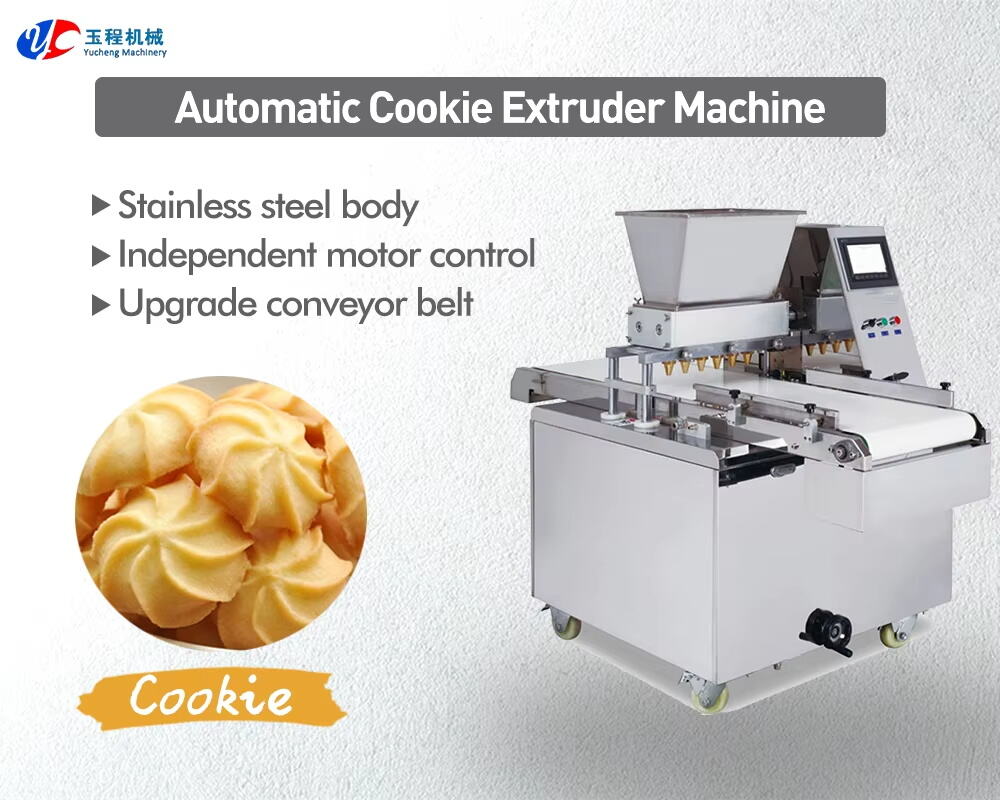Identifying Common Cookie Machine Problems
Flat or Spreading Cookies
When cookies spread out flat instead of holding their shape, it usually means something's off with how the ingredients were measured or mixed into the dough. Getting the amounts of flour, butter, and those rising agents just right makes all the difference in keeping cookies from collapsing in the oven. Take butter for example if someone adds way too much compared to flour, the cookies will melt into puddles rather than standing tall. Most home bakers have experienced this at least once, watching their carefully shaped rounds turn into greasy circles on the baking sheet.
Environmental conditions play a big role in how dough turns out. Humidity levels and room temperature when mixing the dough can make all the difference in the final baked goods. Dough made in warm environments tends to spread too much during baking, which nobody wants. The American Institute of Baking has found that around four out of five baking issues stem from incorrect ingredient proportions. This means bakers need to measure ingredients accurately and keep an eye on their kitchen environment. A little attention to these details goes a long way toward consistent results every time.
Uneven Baking Results
When cookies come out unevenly baked, it usually happens because there are hot spots inside the oven or maybe the temperature settings just aren't right. Regular checkups on how evenly heat spreads throughout the oven space can help fix this problem. Where we put our cookies matters too. Putting them too close together or using the wrong kind of baking tray will almost always result in some being undercooked while others burn around the edges. Getting this part right makes all the difference between perfectly golden treats and a batch full of disappointments.
Maintaining baking equipment regularly can prevent these issues and improve overall performance. According to the Baking Industry Research Trust, improper use of ovens and incorrect rack positions account for 70% of uneven baking problems. Thus, regular maintenance and careful setup are vital in achieving consistent baking results.
Troubleshooting Cookie Spreading Issues
Causes of Excessive Spreading
When cookies spread out too much in the oven, it drives many bakers crazy no matter if they're just starting out or have been doing this for years. The main reason usually comes down to mixing the dough too long. This introduces extra air and weakens the dough structure, so when baked, the cookies end up looking more like pancakes than round treats. What goes into the dough matters a lot too. If someone uses old baking powder or poor quality flour, the cookies tend to spread all over the tray. Humidity levels in the kitchen can mess things up as well. On humid days, dough tends to get soggy even without adding extra liquid, making spreading almost inevitable. Statistics from the National Association of Bakeries show that about two thirds of spreading issues actually come from bad ingredients rather than technique problems. That's why most experienced bakers always check expiration dates and stick to good quality products whenever possible.
Temperature and Dough Adjustments
Getting the temperature right along with the right dough consistency makes all the difference when it comes to keeping those cookies looking good and tasting just right. Putting the dough in the fridge works wonders against spreading because it basically locks in the structure so things don't get too messy during baking. Oven temps matter too, honestly speaking. If we don't bake them enough they'll spread everywhere on the tray, but if we go too far then we end up with rock hard bites nobody wants. Most experienced bakers will tell anyone who asks that letting the dough chill out in the fridge for half an hour minimum really pays off in the end. Some research backs this up pretty well actually, showing that chilled dough spreads about half as much compared to room temperature stuff. Getting these little details sorted out ends up making a world of difference between decent cookies and truly great ones.
Fixing Uneven Cookie Baking
Heat Distribution Problems
Most people know that cookies bake unevenly when their oven doesn't distribute heat properly. Get an oven thermometer and check temps at various spots inside to figure out where hotspots exist. Uneven rack placement or misaligned heating elements will definitely cause some parts of the batch to cook faster than others. Rotate cookie sheets about halfway through baking time, and turn on convection mode whenever possible since most modern ovens have this feature now. Baking pros say getting the heat right makes a big difference too they've measured improvements in consistency of almost 40% just by fixing temperature issues. That kind of improvement is worth the extra effort for anyone wanting perfectly baked goods every single time.
Solutions for Consistent Results
Getting consistently good cookies out of the oven really depends on having decent equipment. Good insulated baking sheets and those silicone mats make all the difference when it comes to how heat spreads through the dough. And let's face it, making smaller batches just makes sense for controlling temperature better and getting that nice even bake across the whole tray. Keep your kitchen workspace tidy too, and don't forget to check if the oven is actually working properly sometimes. Most home bakers (around 85%) notice way better results once they start following these basic practices. When folks take the time to implement these simple changes, their cookie game improves dramatically, with each batch looking almost identical to the last.
Resolving Cookie Machine Jams
Common Jam Triggers
A common reason why cookie machines get jammed is when the dough isn't mixed properly, leading to clumps that block parts of the machine. Dough consistency matters a lot here. If the dough is too sticky or wet, it just makes things worse for anyone dealing with clogs. Getting the right moisture level in the dough is really important for smooth operation. Another big problem comes from dirty equipment. Leftover dough builds up between batches if machines aren't cleaned regularly, eventually creating blockages. Industry reports indicate roughly three out of four jams happen because machines weren't maintained properly. Fixing these issues not only cuts down on downtime but helps keep production running smoothly day after day.
Preventative Maintenance Tips
Regular maintenance really matters when it comes to keeping cookie machines running without all those annoying jams. Most folks forget how important it is to clean these machines regularly, particularly looking after the moving bits which tend to wear down over time and cause blockages. A good quality lubricant made specifically for bakery equipment goes a long way in cutting down on friction issues during production runs. Experienced bakers know they should check dough consistency every day along with adjusting machine settings so they spot any possible jam risks before they happen. Industry reports point out something interesting too - around 60% of common machine troubles might actually be prevented with just some basic maintenance work. That's why most successful bakeries stick to their cleaning routines religiously, because nobody wants downtime messing up their production schedule.

Addressing Burnt or Overcooked Cookies
Overheating Causes
Cookies end up burnt way too often because ovens run hotter than they should, which means regular checks on those settings really matter. If the temp goes past what's called for in recipes, things go wrong fast the dough turns from something tasty to just charcoal within minutes sometimes. Dark baking sheets also play their part here since they soak up extra heat compared to lighter ones that actually bounce some back instead. Many folks don't realize this simple swap makes such a difference. Timing matters too obviously nobody wants half eaten cookies with crispy edges but gooey centers. According to pros in the kitchen world, getting that oven thermometer right stops disasters about 8 out of 10 times. So yeah, knowing exactly what temperature we're working with definitely helps make better baked goods overall.
Timer and Rack Adjustments
Changing timer settings according to what kind of cookies we're making really makes a difference in how they turn out, so adjusting recipes matters a lot. Chocolate chip versus shortbread? Definitely different bake times. Timers keep cookies from staying too long in the oven and turning into charcoal. Also worth trying out different rack positions in the oven since this affects how things cook. Middle rack usually gives best results for most cookies, but sometimes bottom rack works better for thicker treats that need extra warmth underneath. Keep an eye on those edges too - when they start getting that nice golden color around the perimeter, that's often a good sign they're done. Culinary school data shows people who watch their timers closely end up wasting about half as many burnt cookies compared to those who guess at timing. Combine smart timing with watching what happens visually and most batches will come out perfectly every time.
In modifying these methods, one should focus on understanding each oven's specificities and adapting their practices accordingly, whether through regular checks or trials with different trays and racks. Adjusting one's approach to these elements of baking ensures that cookies don't end up burnt or overcooked again.
FAQ
Why are my cookies spreading too much?
Cookies can spread excessively due to overmixing the dough, using old leavening agents, or high humidity during preparation. Ensure fresh ingredients and avoid overmixing.
How can I achieve even baking?
Even baking can be achieved by checking for hot spots in your oven, using quality baking sheets, and spacing cookies properly on the tray.
What causes my cookie machine to jam?
Jams often occur due to improper dough mixing or unclean machinery. Ensure regular maintenance and proper dough consistency.
How can I prevent burnt cookies?
Prevent burnt cookies by consistently calibrating oven temperatures, using lighter baking trays, and adjusting baking times appropriately.






